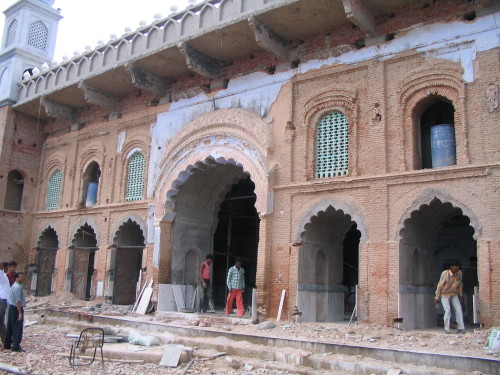
An Old Photograph of Bara Imambara-Bilgram's Renovation
Dr.Mazhar
Naqvi
Bilgram has not received
the attention it deserves from Muharram mourners. The history of Azadari in Bilgram
dates back to the Mughal period and it has not lost its sheen till today,
thanks to arrival of Bilgramis from all over the world to observe Muharram
ceremonies at their native place. Bilgram is a historic but small town of
district Hardoi. But it was an important settlement before the advent of
Lucknow. Imamis have been inhabitants of Bilgram since 13th century.
They trace their lineage to Syed Muhammad Sughra who had arrived in India
during the period of Sultan Iltutmish. He commanded a well-trained army and conquered
the area in and around Bilgram from local rulers called ‘Bharas’ in 1217-18 AD. They made Bilgram
their headquarters and emerged as important power brokers in southern part of
Awadh. Due to their scholarly pursuits and command over warfare, they developed
Bilgram both as a center of Muharram ceremonies and seat of learning. Apart
from producing affluent landlords, Bilgram also produced eminent scholars and
personalities like Allama Azad Bilgrami (1704-1786), Syed Ali
Bilgrami(1851-1911), Imad-ul-Mulk Bahadur Syed Hussain Bilgrami(1842-1926),
Sursuba of Malwa and Isagarh estate Khan Bhadur Syed Ali Bahadur Bilgrami.

The Historic Tazia of Bilgram with dome of Dargah Hazrat Abbas in the Backdrop
Descendants of Syed Sughra also introduced
Marasim-e-Azadari and Taziadari in Bilgram for two month and eight days at a time
when Muharram observance in most of the parts of India was restricted to first
12 days.They also built an impressive Bara Imambara in Bilgram much before the
construction of world famous Bara Imambara by Nawab Asaf- Ud- Daula in Lucknow
by the end of 18th century. They also built a Dargah of Hazrat Abbas
that is believed to be 300 years old. Important Muharram
processions and ceremonies take place in Bilgram on 6th, 7th, 8th, 9th and 10th of Muharram , followed
by Chehllum, Bahattar Tabut and Chup
Tazia processions of Bilgram are also quite famous and draw crowd of devotees
from far off places to pay tribute to the martyrs of Karbala. Being very sensitive
to their Muharram legacy, they began renovation of Bada Imambara after vagary of
weathers left it in a dilapidated condition. The renovation began in 2006 and
continued for several years. The untiring efforts of Imamis have restored the
lost glory of Imambara and the new complex easily accommodate the crowd of
devotees during each Muharram. Imamis have also given a facelift to Dargah of
Hazrat Abbas and its dome and minarets seem to a replica of his shrine in Iraq.
Bada Imambara complex also contains the grave of Syed Ali Bilgrami in its front
courtyard.Notably three Anjumans, Committees formed especially to conduct Muharram ceremonies namely Anjuman Bazm-e- Hussainiya Qadeem, Bazm-e- Azaay-e-Hussain and Gulzar-e-Hussaini supervise and organise programs related to Ayam-E-Aza. (References available on request.Photo Courtesy Google Images )
No comments:
Post a Comment